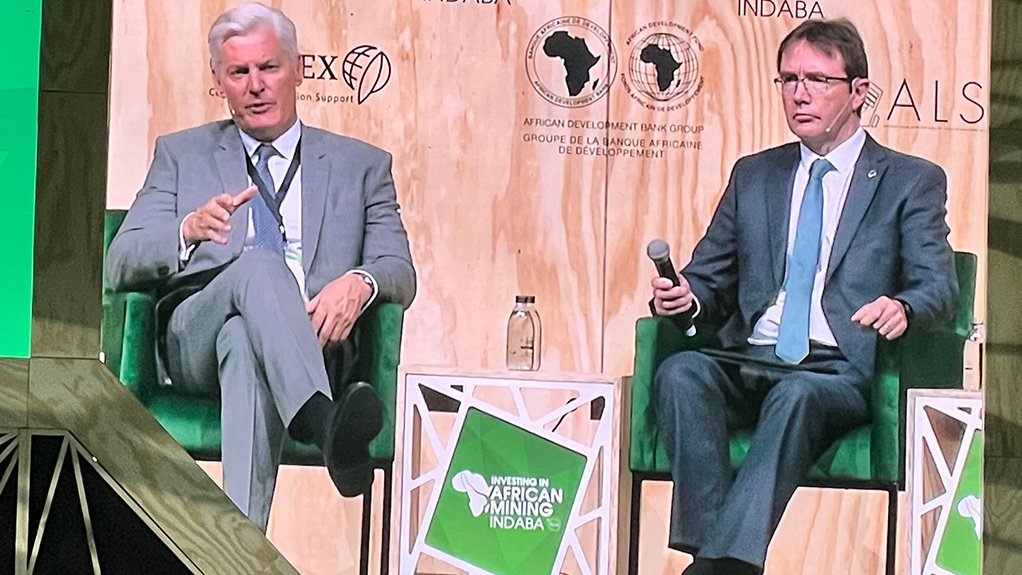CAPE TOWN (miningweekly.com) – The coal-to-renewables initiative of Seriti Green, the 91% black-owned and black-controlled Seriti Coal associate, came in for special praise at the interesting fireside chat between outgoing Eskom CEO André de Ruyter and outgoing Minerals Council South Africa CEO Roger Baxter on the second day of the Investing in African Mining Indaba.
Seriti Green is building a 900 MW wind farm in South Africa’s electricity heartland of Mpumalanga, much of which will be used by the coal mines of the Seriti group as part of a decarbonisation initiative.
“The electricity crisis is a constraint to investors, that’s very clear, and that is why we need to resolve it as quickly as possible,” De Ruyter said during the conversation covered by Mining Weekly.
“First of all, I think credit should go to the minerals sector for being true partners in helping us to manage this crisis. The levels of cooperation that we get from the Minerals Council and the Energy Intensive Users Group (EIUG) is very heartening and it enables us to weather some of our unreliability in a far better way than otherwise would be the case,” said De Ruyter.
But ultimately, the consensus between De Ruyter and Baxter is that South Africa needs more power capacity – and has, in fact, needed more capacity since 1998, when Baxter was negotiating an electricity White Paper with the South African government.
The greater capacity on the national electricity grid is needed to allow State utility Eskom to carry out its maintenance of its fleet of ageing coal-fired power stations.
Without that capacity, Eskom has had to “really struggle” – in the words of De Ruyter – to keep the system performing “as best we can” – and clearly “as best we can” has not been good enough to address the loadshedding problem.
Currently, units 1, 2 and 3 of the new Kusile power station are down, depriving the grid of 2 180 MW.
One unit at the Koeberg nuclear power station will be down for most of the year, depriving the grid of 928 MW.
There has been a fire at Kusile Unit 5, which should have been synchronised onto the grid this month, which is now extended to July, depriving the grid of another 700 MW, and Unit 4 at the also new Medupi power station, which is putting paid to another 720 MW.
Added together, that totals some 3 GW to 4 GW of capacity that is structurally absent and the balance has to be made up by a pretty unstable and unreliable coal-fired system.
“So, the outlook for 2023 is a tough one but now you come to what is in the project pipeline, and this is where you see significant and pretty far-sighted investments from a company like Seriti, for example,” said De Ruyter.
“Eventually, they’re going to install 900 MW of wind and solar, right in the heart of Mpumalanga’s coal belt, which, of course, is a great contributor to the Just Energy Transition, creating jobs for coal miners from people who have invested in coal for many years.
“You look at a company like Anglo American converting some of their trucks to hydrogen, which they are fuelling with the hydrogen plant that they’ve built on site.
“Increasingly, we are seeing that we are able to attract more private sector generation capacity to the grid. We see it in our statistics and we also see it in numbers collated by [National Energy regulator of South Africa].
“There’s more than 9 000 MW of new capacity that is either in the process of being built or in the process of going through engineering and financial close and environmental impact assessment (EIA) processes to get them into the grid.
“Our anticipation is that from calendar 2024 onwards, we should see a reduction in the incidence of loadshedding and the important thing to emphasis is that we shouldn’t stop there.
“We have an ageing fleet, an unreliable fleet that has been poorly maintained and we should not sit back and become complacent again and be content to have 9 000 MW in the grid.
“We’ve got to double-down and we’ve got to accelerate and this is, Roger, where I think the Presidency’s structural reforms that President Cyril Ramaphosa implemented in his speech of the 25th of July last year hasn’t nearly received the credit that it should have for liberalising the generation sector,” said De Ruyter, who credited many Minerals Council South Africa members of taking advantage of that liberalisation.
Baxter recalled that the Minerals Council and the EIUG back in February last year deployed personnel into the Presidency to help with understanding what the specific energy constraints were, one being why mining companies with long completed EIAs have to wait 18 months to obtain approval for a solar project..
“And the President joked back to me saying, ‘Roger, I think I need to go to that department and find out what they do.
“I think what we’ve done is through the reforms that have come out and the electricity recovery plan that came out in July, those are the biggest structural reforms that we’ve seen in South Africa in 25 years, in my view, that basically unlock the private sector’s capability to invest in an energy system, which is also needed to improve logistics,” said Baxter.
EMAIL THIS ARTICLE SAVE THIS ARTICLE ARTICLE ENQUIRY
To subscribe email subscriptions@creamermedia.co.za or click here
To advertise email advertising@creamermedia.co.za or click here











